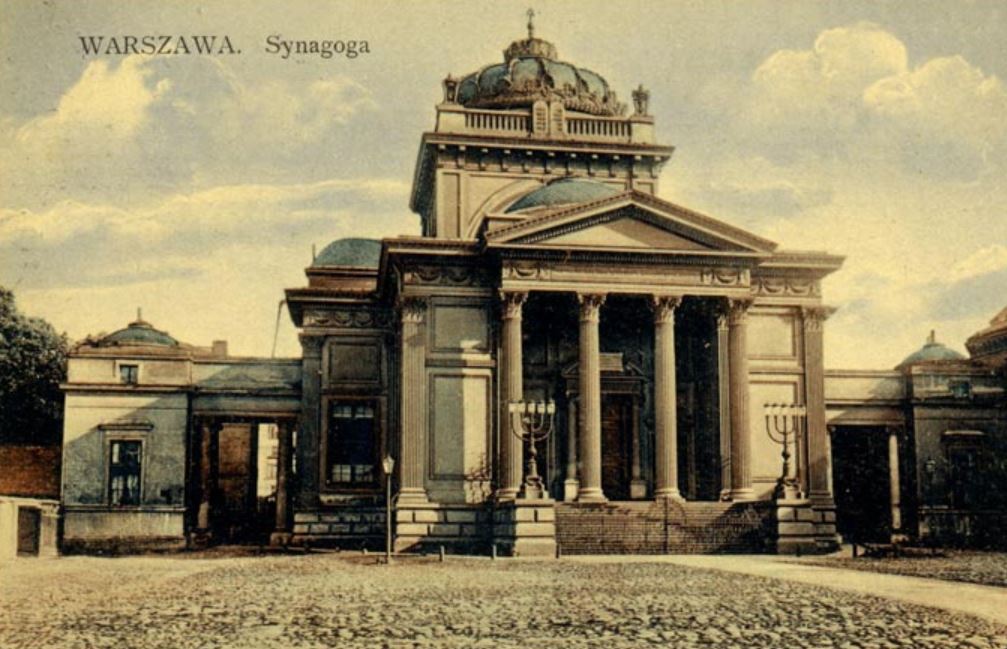Kolejna budowla, którą Wam przedstawiam stała na miejscu znanego nam wszystkim Błękitnego Wieżowca.
Wielka Synagoga, bo o niej mowa była największą synagogą w Warszawie i niewątpliwie jedną z najwspanialszych polskich budowli wzniesionych w XIX wieku. Znajdowała się przy placu Tłomackie 7 z którego do dziś nic nie zostało poza budynkiem w którym mieści się Żydowski Instytut Historyczny oraz Grubą Kaśką (studnia) stojącą po środku Trasy WZ.
Wielka Synagoga była symbolem tzw. judaizmu reformowanego, gdzie obrządek był prowadzony po polsku, a wstęp do niej było otwarty również dla chrześcijan. Odbywały się w niej nie tylko nabożeństwa czysto religijne, ale również nabożeństwa z okazji odzyskania niepodległości, uchwalenia Konstytucji 3 Maja, rozpoczęcia roku szkolnego czy nabożeństwo żałobne w dniu śmierci Józefa Piłsudskiego.
Budowa świątyni trwała dwa lata, a zarówno dostarczoną cegłę, jak i prace murarskie wykonał znany Wam już Kazimierz Granzow. Uroczyście otwarta 26 września 1878 roku posiadała dokładnie 2200 miejsc siedzących, 1150 miejsc w sali głównej oraz 1050 miejsc w galerii dla kobiet. W synagodze znajdowały się również biblioteka, posiadającą bardzo bogaty i cenny księgozbiór, starodruki oraz manuskrypty.
16 maja 1943 świątynia została osobiście wysadzona przez Jürgena Stroopa, co było ostatnim aktem zniszczenia przez Niemców Getta żydowskiego a zarazem stłumienia powstania Żydów w Warszawie (19 kwietnia obchodzimy rocznicę wybuchu Powstania w Getcie)
Po zakończeniu wojny rozważano odbudowanie Synagogi, wkrótce jednak ruiny usunięto, a miejsce po niej pozostawało przez wiele lat puste.
W latach 50. XX wieku podjęto decyzję o budowie na nim wieżowca ale budowa ciągnęła się przez prawie dwa dziesięciolecia, co usprawiedliwiano w prasie nałożeniem klątwy przez rabinów. Ostatecznie, po wielu zmianach projektów, około roku 1976 wzniesiono stalowy szkielet budynku, obłożono go złocistymi blachami i…. i budowa zamarła, a szkielet budynku zaczął rdzewieć.
Dopiero pod koniec lat 80. po podpisaniu umowy z jugosłowiańską firmą General Export-Giposs ruszyła kontynuacja budowy. Złociste blachy zamieniono na srebrzyste, odbijające barwę nieba, rozbudowano także podium budynku, nawiązujące kształtem właśnie do Wielkiej Synagogi.
Budowę ukończono w 1991 roku, co tłumaczono w prasie odczynieniem klątwy przez usatysfakcjonowanych rabinów ;).
Dwa pierwsze zdjęcia pokazują front Synagogi oraz część Placu Tłomackie, możemy również zobaczyć jak wyglądało wnętrze świątyni. Kolejne to ruiny po jej wysadzeniu (z tyłu widać Arsenał); układ przedwojenny tej części miasta (na czerwono nieistniejące budynki – mapa z serwisu Warszawa1939) oraz zdjęcie lotnicze z Google Earth z 1945 roku, gdzie widać ogrom zniszczeń w tej części miasta łącznie z Placem Bankowym (zwróćcie uwagę na jego przedwojenny trójkątny kształt), następnie teraźniejszy widok Blue Tower (również z Google Earth). Ostatnie to zrobione dziś od strony Arsenału (po prawej Gruba Kaśka).
Another building that I present to you stood on the site of the Blue Tower we all know.
The Great Synagogue, as we are talking about it, was the largest synagogue in Warsaw and undoubtedly one of the most magnificent Polish buildings erected in the 19th century. It was located at 7 Tłomackie Square, of which to this day nothing has been left except the building where the Jewish Historical Institute is located and the Gruba Kaśka (well) standing in the middle of the WZ Route.
The Great Synagogue was a symbol of the so-called Reform Judaism, where the rite was conducted in Polish, and admission to it was also open to Christians. Not only purely religious services were held there, but also services on the occasion of regaining independence, the adoption of the May 3 Constitution, the beginning of the school year, or a memorial service on the day of Józef Piłsudski’s death.
The construction of the temple lasted two years, and both the delivered brick and masonry works were performed by Kazimierz Granzow, who is already known to you. Solemnly opened on September 26, 1878, it had exactly 2,200 seats, 1,150 seats in the main hall and 1,050 seats in the women’s gallery. There was also a library in the synagogue with a very rich and valuable collection of books, old prints and manuscripts.
On May 16, 1943, the temple was personally blown up by Jürgen Stroop, which was the last act of the destruction of the Jewish Ghetto by the Germans and the suppression of the Jewish uprising in Warsaw (April 19, we celebrate anniversary of the Ghetto Uprising)
After the end of the war, the Synagogue was being rebuilt, but the ruins were soon removed and the site remained empty for many years.
In the 1950s, a decision was made to build a skyscraper on it, but the construction lasted for almost two decades, which was justified in the press by the curse by the rabbis. Finally, after many design changes, around 1976, the steel skeleton of the building was erected, covered with golden sheets and…. and construction froze, and the skeleton of the building began to rust.
Only at the end of the 1980s, after signing a contract with the Yugoslav company General Export-Giposs, the construction was continued. The golden metal sheets were replaced with silvery ones reflecting the color of the sky, the podium of the building was also extended, referring to the shape of the Great Synagogue.
The construction was completed in 1991, which was explained in the press by the dissatisfied rabbis lifting the curse;).
The first two photos show the front of the Synagogue and a part of Tłomackie Square, we can also see what the interior of the temple looked like. Another are the ruins after it blows up (the Arsenal can be seen in the back); pre-war layout of this part of the city (non-existent buildings in red – map from the website Warszawa1939) and an aerial photo from Google Earth from 1945, where you can see the enormity of the destruction in this part of the city, including Bankowy Square (note its pre-war triangular shape), then the present one Blue Tower view (also from Google Earth). The last one was made today from the side of the Arsenal (on the right Gruba Kaśka).

